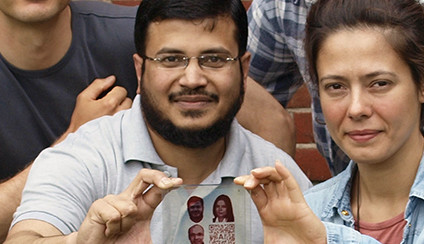Inkjet printing of text or photos as solar cells.

Research is in progress at the University of Aalto in Finland on the development of a process for inkjet printing of text, photos or any illustrations as solar cells. The idea is not new, but these researchers are covering new ground which will allow the use of ordinary materials.
Research is in progress at the University of Aalto in Finland on the development of a process for inkjet printing of text, photos or any illustrations as solar cells. The idea is not new but these researchers are covering new ground which will allow the use of ordinary materials. According to Janne Halme: “The difficulty has been the development of solvents which are both clean and photovoltaic and give a good print quality”.
Light absorbed by ordinary inks is transformed into heat; a photovoltaic ink transforms it into electricity. The darker the ink, the better it works, so for now black is the best.
The advantage of such decorative (and eventually multicolored) solar panels is to give a less austere look than plain panels. By making the panels more attractive, with graphic motifs, they can more easily be incorporated into a living space. Any surface can theoretically both carry an image and / or text, and also serve as a solar panel.
The first attempts are encouraging. The yield obtained with the experimental printed solar cells is promising. According to Ghufran Hashmi, post-doctoral researcher in Physics, the first 1000 hours of testing with exposure to intense heat and light at EPFL in Lausanne where he is a guest researcher, went well.
If you would like to know more about the nature and substances used, please refer to the following scientific article: Dye-sensitized solar cells with inkjet-printed dyes.
Light absorbed by ordinary inks is transformed into heat; a photovoltaic ink transforms it into electricity. The darker the ink, the better it works, so for now black is the best.
The advantage of such decorative (and eventually multicolored) solar panels is to give a less austere look than plain panels. By making the panels more attractive, with graphic motifs, they can more easily be incorporated into a living space. Any surface can theoretically both carry an image and / or text, and also serve as a solar panel.
The first attempts are encouraging. The yield obtained with the experimental printed solar cells is promising. According to Ghufran Hashmi, post-doctoral researcher in Physics, the first 1000 hours of testing with exposure to intense heat and light at EPFL in Lausanne where he is a guest researcher, went well.
If you would like to know more about the nature and substances used, please refer to the following scientific article: Dye-sensitized solar cells with inkjet-printed dyes.
